heating TOYOTA URBAN CRUISER 2011 Owners Manual
[x] Cancel search | Manufacturer: TOYOTA, Model Year: 2011, Model line: URBAN CRUISER, Model: TOYOTA URBAN CRUISER 2011Pages: 532, PDF Size: 27.93 MB
Page 171 of 532

171 2-1. Driving procedures
2
When driving
URBAN CRUISER_EE (OM52C21E)
CAUTION
Exhaust gases
Exhaust gases include harmful carbon monoxide (CO), which is colorless
and odorless. Inhaling exhaust gases may lead to death or a serious health
hazard.
If the vehicle is in a poorly ventilated area, stop the engine. In a closed
area, such as a garage, exhaust gases may collect and enter the vehicle.
This may lead to death or a serious health hazard.
The exhaust should be checked occasionally. If there is a hole or crack
caused by corrosion, damage to a joint or abnormal exhaust noise, be
sure to have the vehicle inspected and repaired by any authorized Toyota
dealer or repairer, or another duly qualified and equipped professional.
Failure to do so may allow exhaust gases to enter the vehicle, resulting in
death or a serious health hazard.
When taking a nap in the vehicle
Always turn the engine off. Otherwise, if you accidentally move the shift lever
or depress the accelerator pedal, this could cause an accident or fire due to
engine overheating. Additionally, if the vehicle is parked in a poorly venti-
lated area, exhaust gases may collect and enter the vehicle, leading to
death or a serious health hazard.
Page 188 of 532
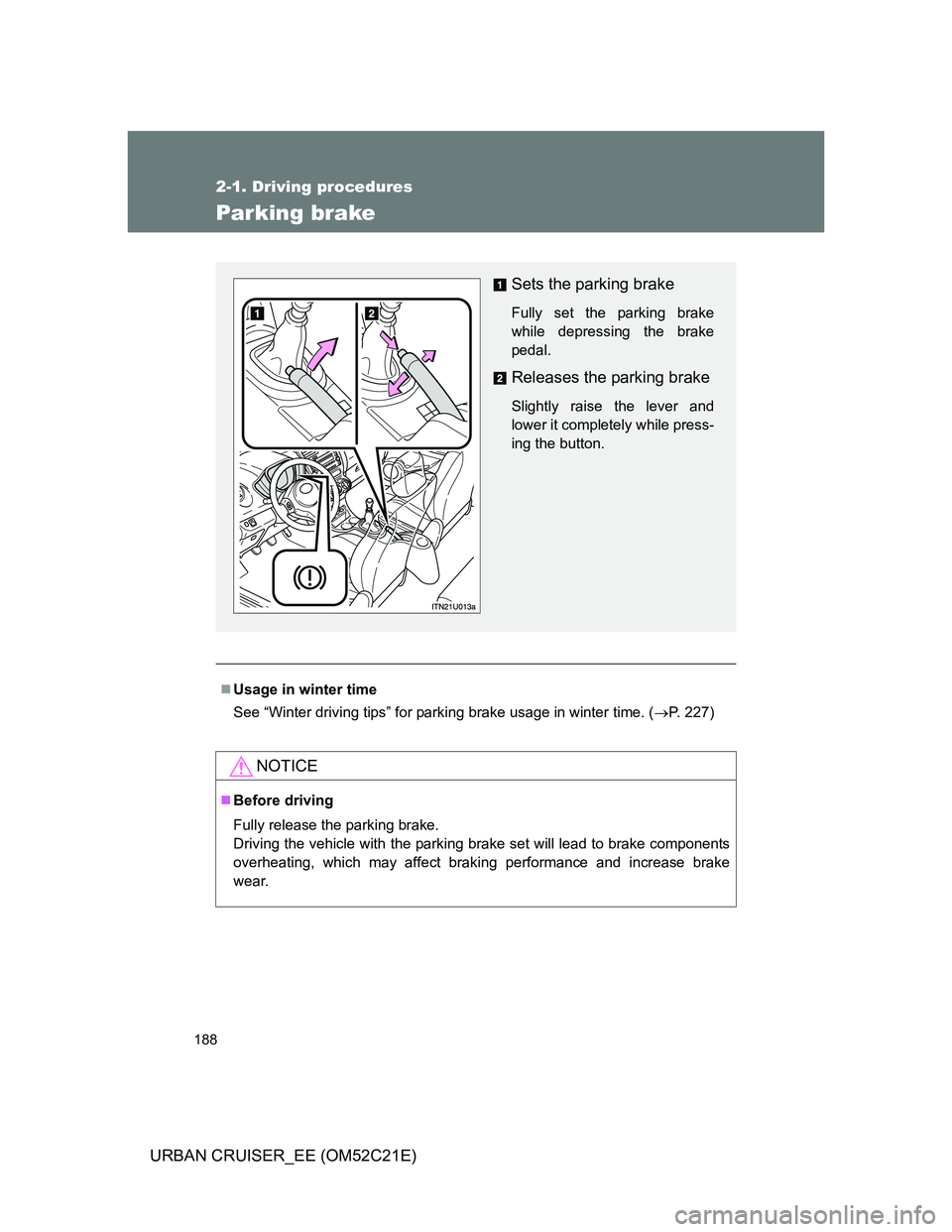
188
2-1. Driving procedures
URBAN CRUISER_EE (OM52C21E)
Parking brake
Usage in winter time
See “Winter driving tips” for parking brake usage in winter time. (P. 227)
NOTICE
Before driving
Fully release the parking brake.
Driving the vehicle with the parking brake set will lead to brake components
overheating, which may affect braking performance and increase brake
wear.
Sets the parking brake
Fully set the parking brake
while depressing the brake
pedal.
Releases the parking brake
Slightly raise the lever and
lower it completely while press-
ing the button.
Page 191 of 532
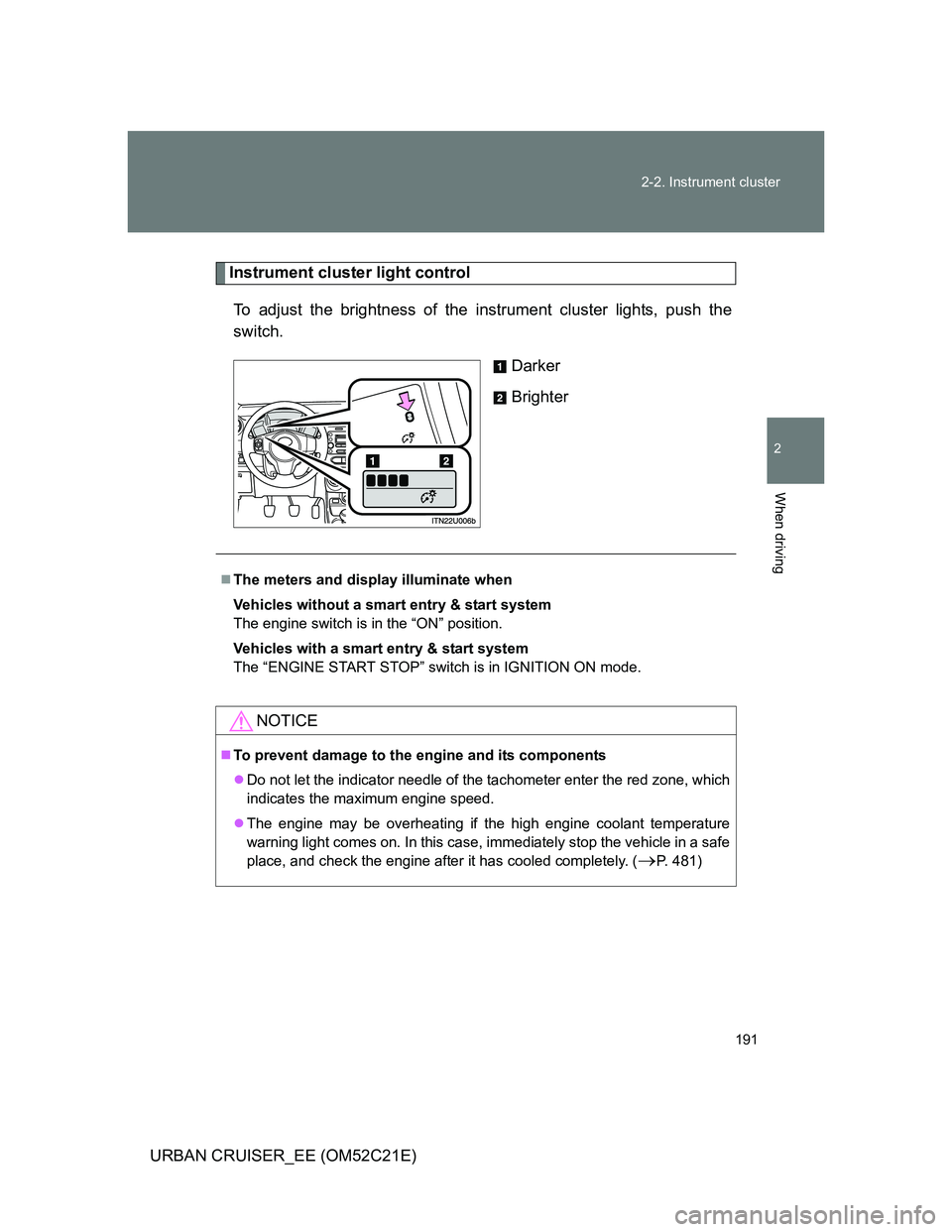
191 2-2. Instrument cluster
2
When driving
URBAN CRUISER_EE (OM52C21E)
Instrument cluster light control
To adjust the brightness of the instrument cluster lights, push the
switch.
Darker
Brighter
The meters and display illuminate when
Vehicles without a smart entry & start system
The engine switch is in the “ON” position.
Vehicles with a smart entry & start system
The “ENGINE START STOP” switch is in IGNITION ON mode.
NOTICE
To prevent damage to the engine and its components
Do not let the indicator needle of the tachometer enter the red zone, which
indicates the maximum engine speed.
The engine may be overheating if the high engine coolant temperature
warning light comes on. In this case, immediately stop the vehicle in a safe
place, and check the engine after it has cooled completely. (
P. 481)
Page 193 of 532
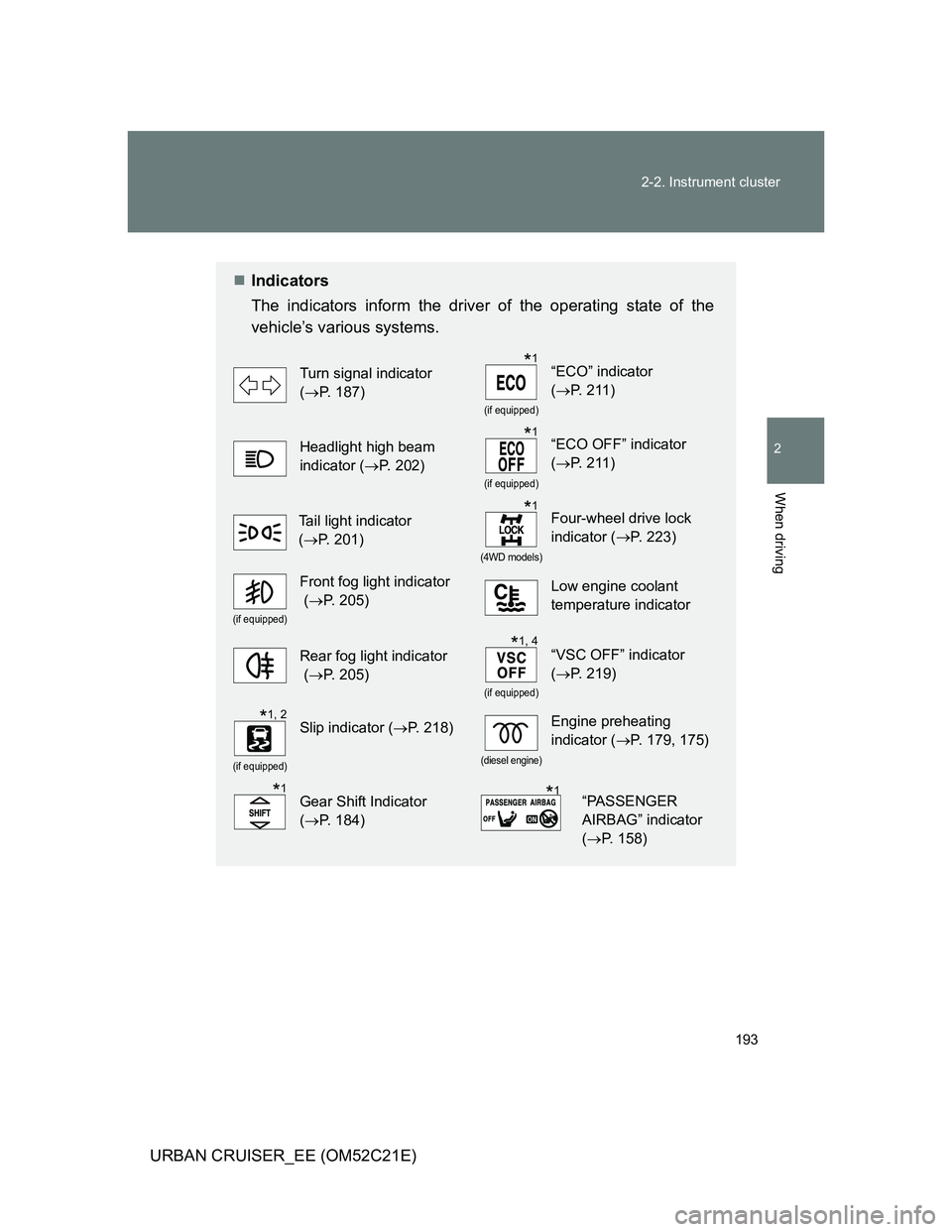
193 2-2. Instrument cluster
2
When driving
URBAN CRUISER_EE (OM52C21E)
Indicators
The indicators inform the driver of the operating state of the
vehicle’s various systems.
Turn signal indicator
(P. 187)
(if equipped)
“ECO” indicator
(P. 2 1 1 )
Headlight high beam
indicator (P. 202)
(if equipped)
“ECO OFF” indicator
(P. 2 1 1 )
Tail light indicator
(P. 201)
(4WD models)
Four-wheel drive lock
indicator (
P. 223)
(if equipped)
Front fog light indicator
(P. 205)Low engine coolant
temperature indicator
Rear fog light indicator
(P. 205)
(if equipped)
“VSC OFF” indicator
(P. 219)
(if equipped)
Slip indicator (P. 218)
(diesel engine)
Engine preheating
indicator (P. 179, 175)
Gear Shift Indicator
(P. 184)“PASSENGER
AIRBAG” indicator
(P. 158)
*1
*1
*1
*1, 4
*1, 2
*1*1
Page 220 of 532
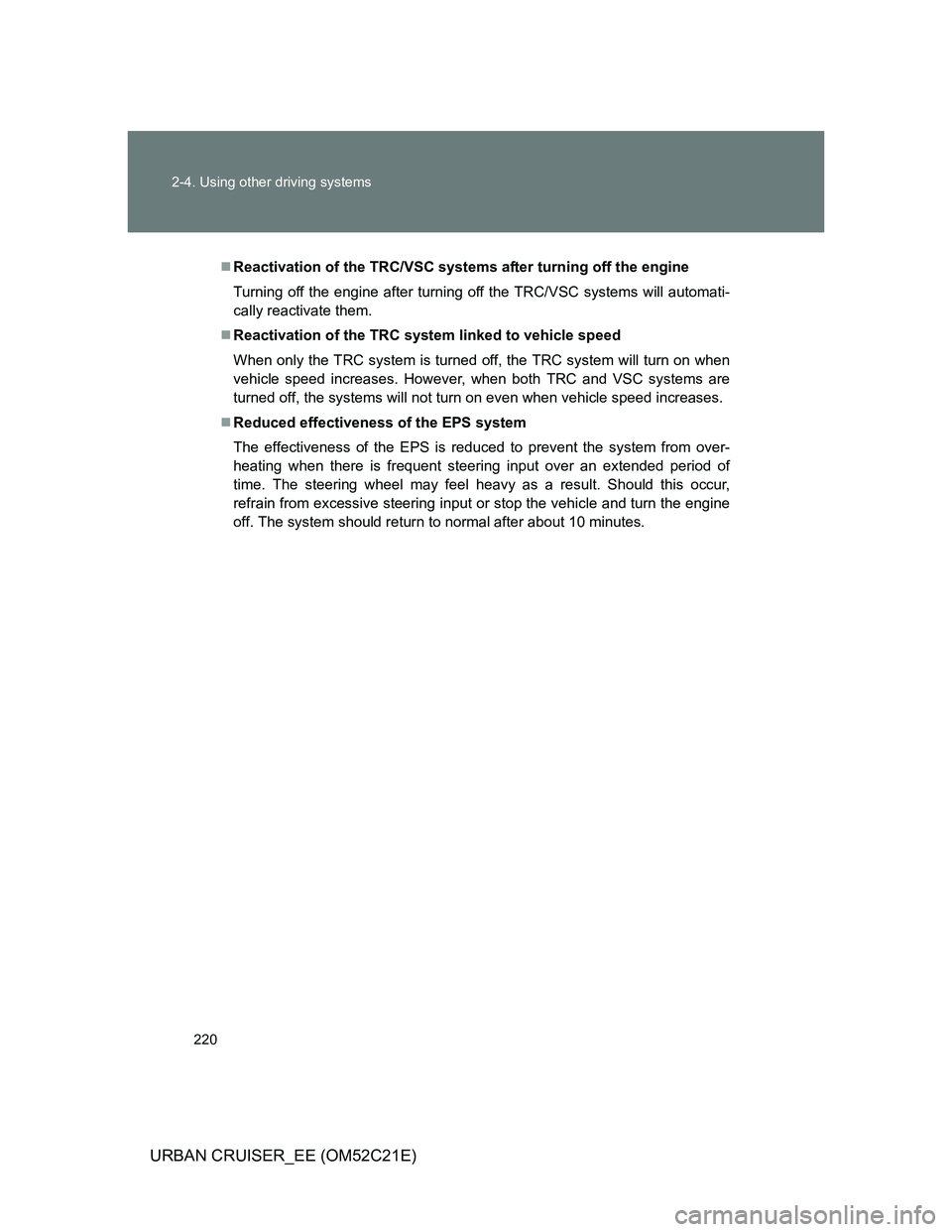
220 2-4. Using other driving systems
URBAN CRUISER_EE (OM52C21E)
Reactivation of the TRC/VSC systems after turning off the engine
Turning off the engine after turning off the TRC/VSC systems will automati-
cally reactivate them.
Reactivation of the TRC system linked to vehicle speed
When only the TRC system is turned off, the TRC system will turn on when
vehicle speed increases. However, when both TRC and VSC systems are
turned off, the systems will not turn on even when vehicle speed increases.
Reduced effectiveness of the EPS system
The effectiveness of the EPS is reduced to prevent the system from over-
heating when there is frequent steering input over an extended period of
time. The steering wheel may feel heavy as a result. Should this occur,
refrain from excessive steering input or stop the vehicle and turn the engine
off. The system should return to normal after about 10 minutes.
Page 239 of 532
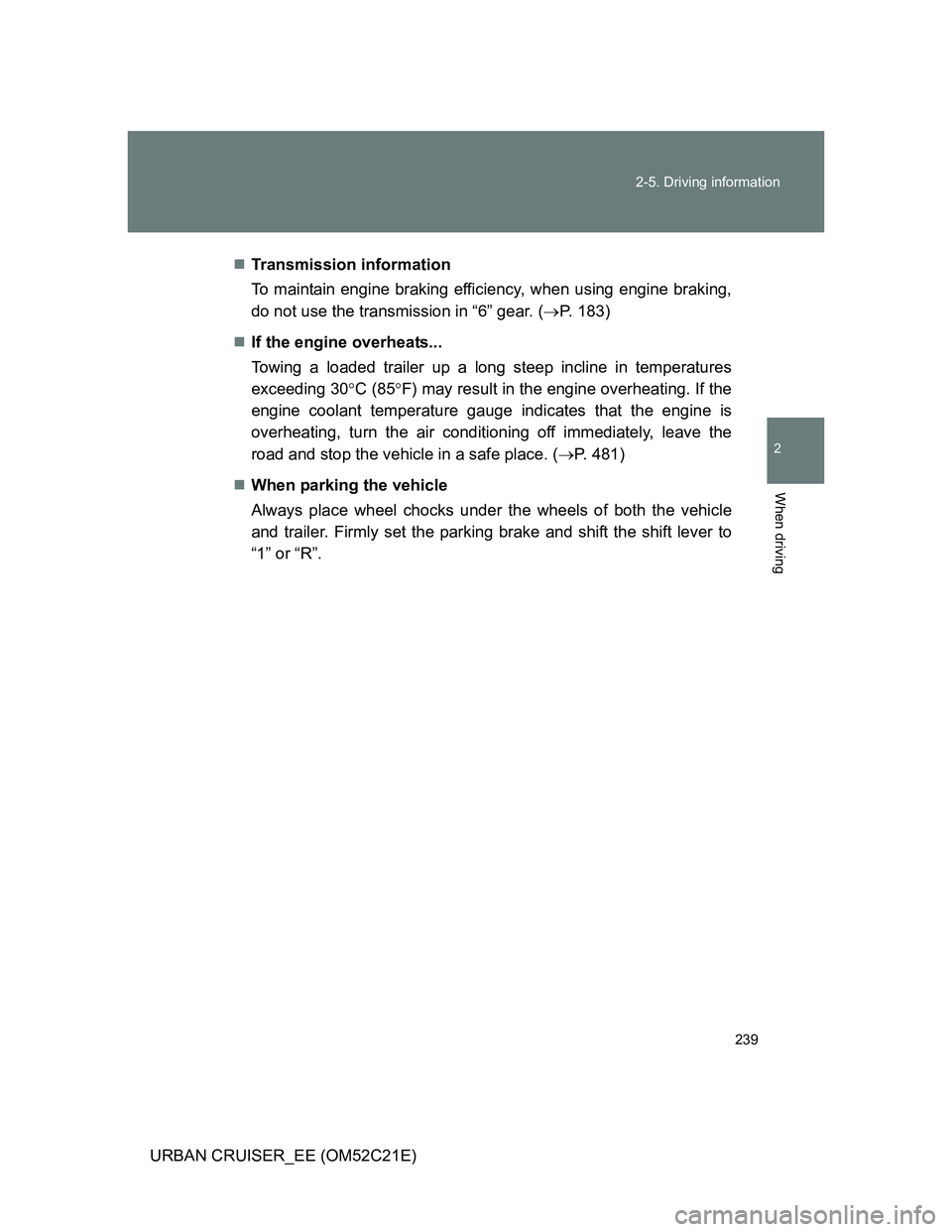
239 2-5. Driving information
2
When driving
URBAN CRUISER_EE (OM52C21E)Transmission information
To maintain engine braking efficiency, when using engine braking,
do not use the transmission in “6” gear. (P. 183)
If the engine overheats...
Towing a loaded trailer up a long steep incline in temperatures
exceeding 30C (85F) may result in the engine overheating. If the
engine coolant temperature gauge indicates that the engine is
overheating, turn the air conditioning off immediately, leave the
road and stop the vehicle in a safe place. (P. 481)
When parking the vehicle
Always place wheel chocks under the wheels of both the vehicle
and trailer. Firmly set the parking brake and shift the shift lever to
“1” or “R”.
Page 240 of 532
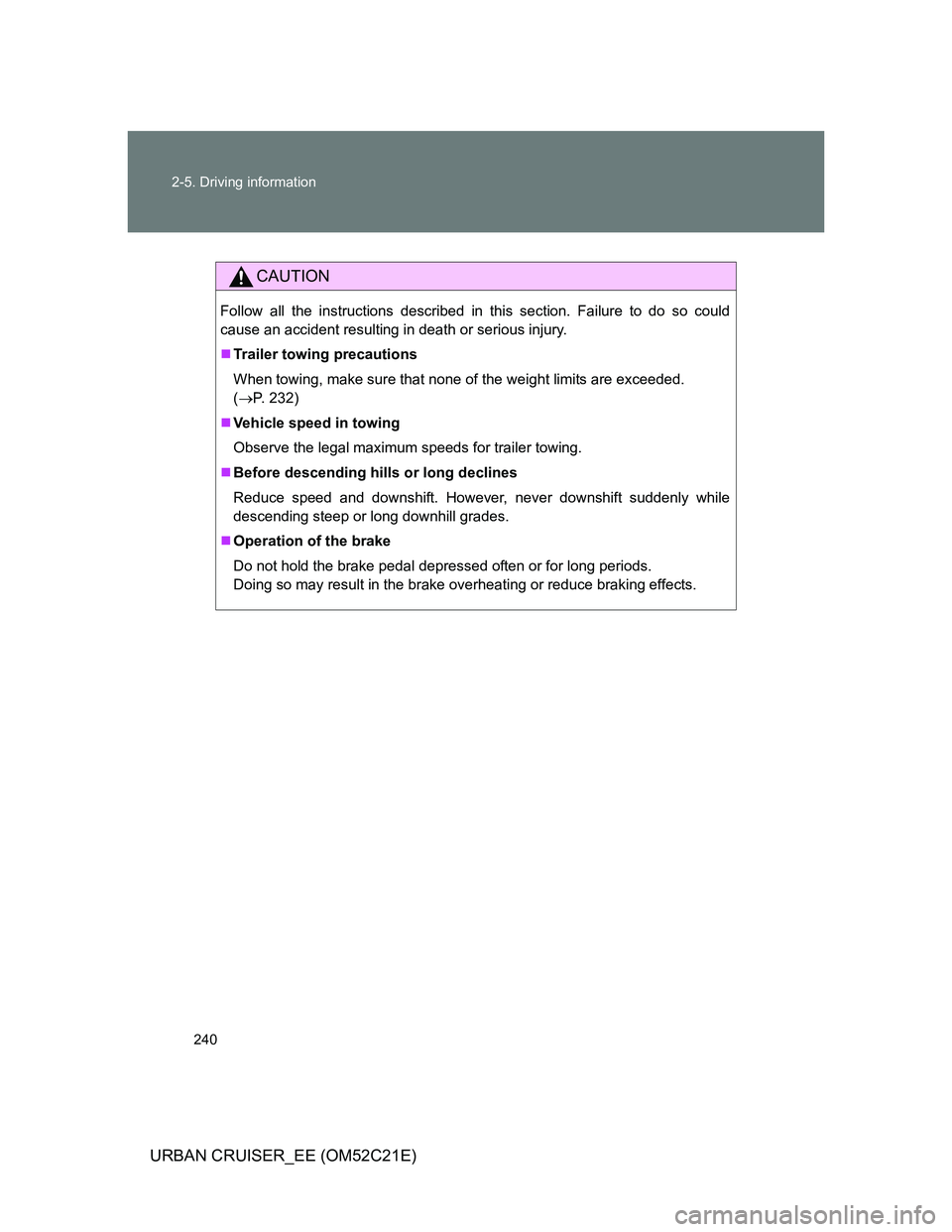
240 2-5. Driving information
URBAN CRUISER_EE (OM52C21E)
CAUTION
Follow all the instructions described in this section. Failure to do so could
cause an accident resulting in death or serious injury.
Trailer towing precautions
When towing, make sure that none of the weight limits are exceeded.
(P. 232)
Vehicle speed in towing
Observe the legal maximum speeds for trailer towing.
Before descending hills or long declines
Reduce speed and downshift. However, never downshift suddenly while
descending steep or long downhill grades.
Operation of the brake
Do not hold the brake pedal depressed often or for long periods.
Doing so may result in the brake overheating or reduce braking effects.
Page 334 of 532
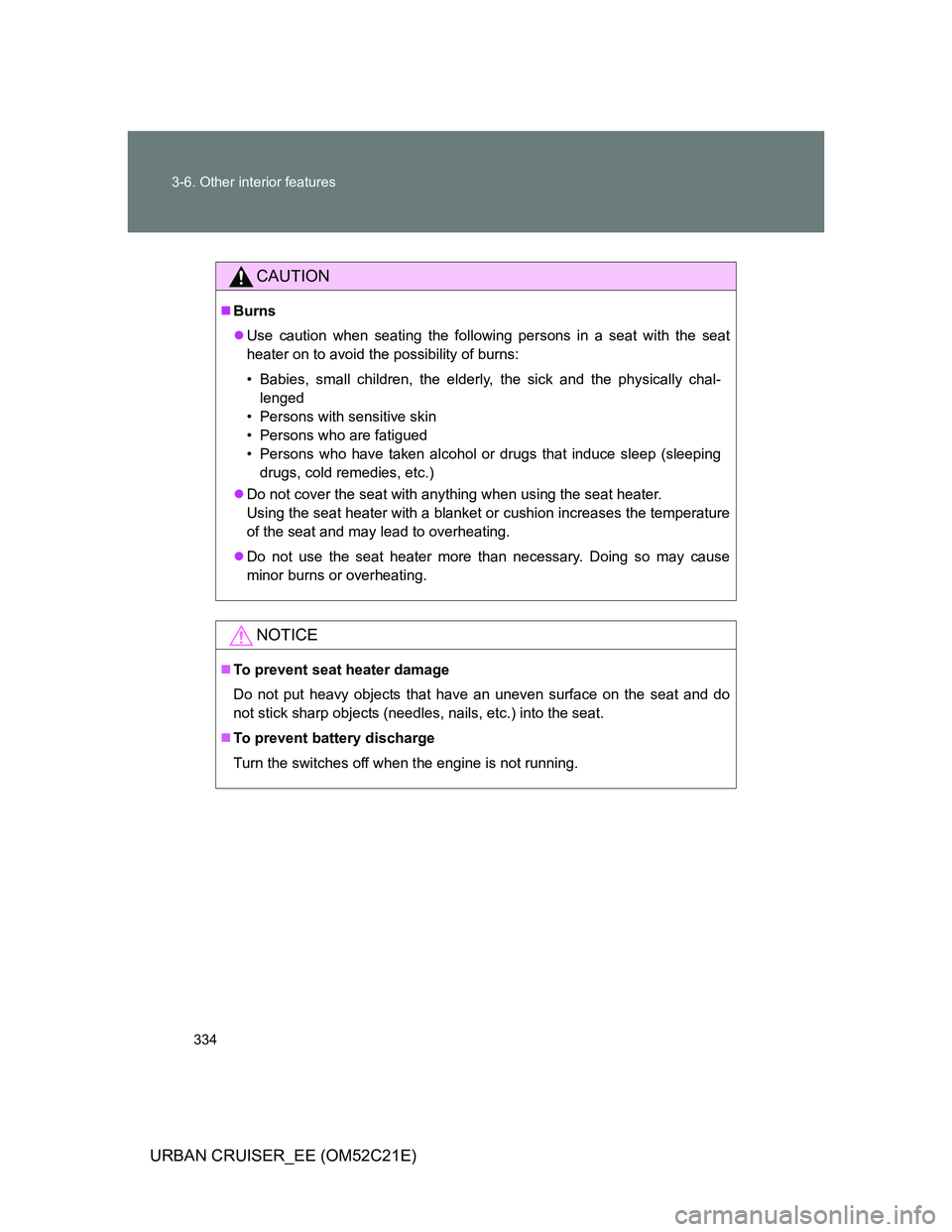
334 3-6. Other interior features
URBAN CRUISER_EE (OM52C21E)
CAUTION
Burns
Use caution when seating the following persons in a seat with the seat
heater on to avoid the possibility of burns:
• Babies, small children, the elderly, the sick and the physically chal-
lenged
• Persons with sensitive skin
• Persons who are fatigued
• Persons who have taken alcohol or drugs that induce sleep (sleeping
drugs, cold remedies, etc.)
Do not cover the seat with anything when using the seat heater.
Using the seat heater with a blanket or cushion increases the temperature
of the seat and may lead to overheating.
Do not use the seat heater more than necessary. Doing so may cause
minor burns or overheating.
NOTICE
To prevent seat heater damage
Do not put heavy objects that have an uneven surface on the seat and do
not stick sharp objects (needles, nails, etc.) into the seat.
To prevent battery discharge
Turn the switches off when the engine is not running.
Page 428 of 532
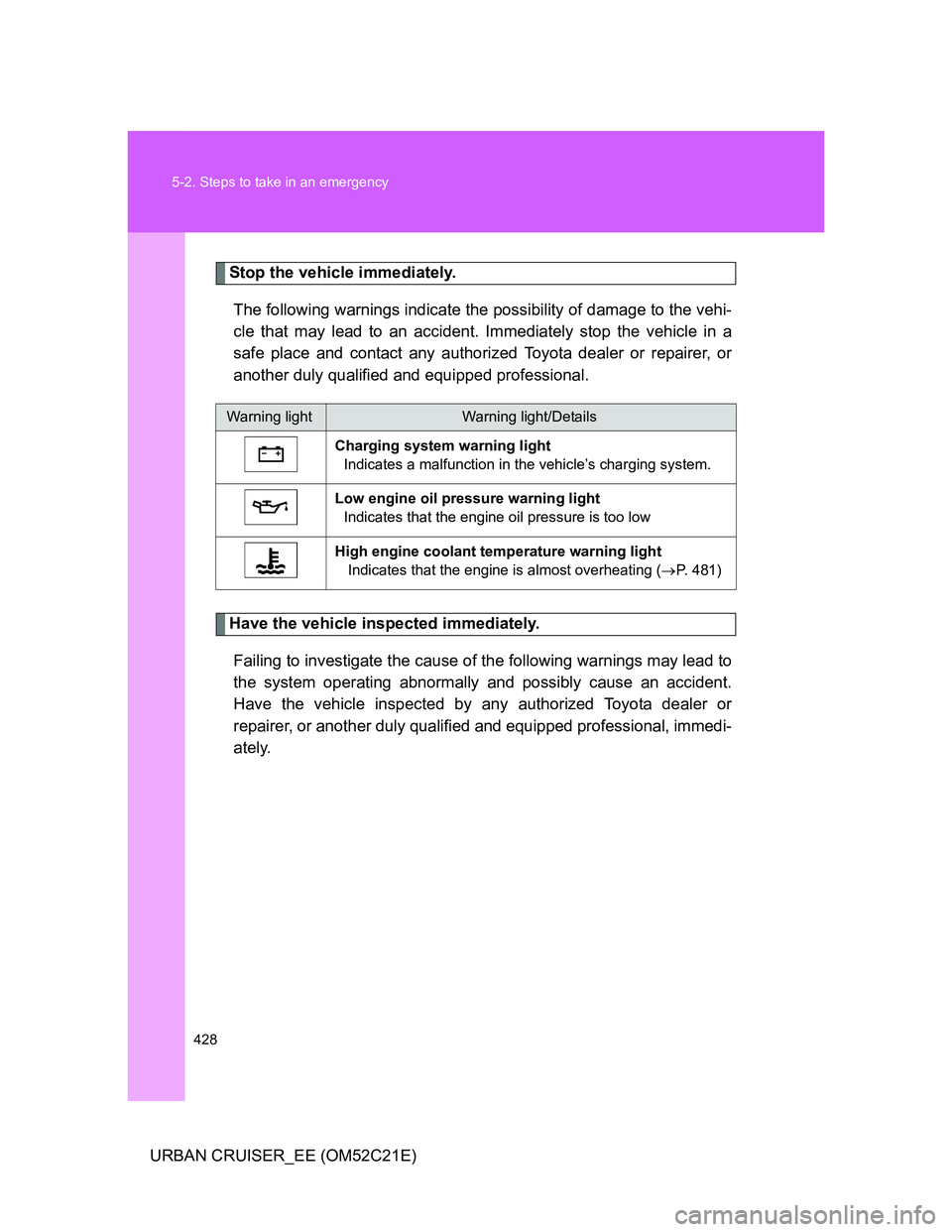
428 5-2. Steps to take in an emergency
URBAN CRUISER_EE (OM52C21E)
Stop the vehicle immediately.
The following warnings indicate the possibility of damage to the vehi-
cle that may lead to an accident. Immediately stop the vehicle in a
safe place and contact any authorized Toyota dealer or repairer, or
another duly qualified and equipped professional.
Have the vehicle inspected immediately.
Failing to investigate the cause of the following warnings may lead to
the system operating abnormally and possibly cause an accident.
Have the vehicle inspected by any authorized Toyota dealer or
repairer, or another duly qualified and equipped professional, immedi-
ately.
Warning lightWarning light/Details
Charging system warning light
Indicates a malfunction in the vehicle’s charging system.
Low engine oil pressure warning light
Indicates that the engine oil pressure is too low
High engine coolant temperature warning light
Indicates that the engine is almost overheating (P. 481)
Page 484 of 532

484 5-2. Steps to take in an emergency
URBAN CRUISER_EE (OM52C21E)
Overheating
If you observe the following, your vehicle may be overheating:
The high engine coolant temperature warning light flashers or comes on
or a loss of power is experienced.
Steam is coming from under the hood.
CAUTION
To prevent an accident or injury when inspecting under the hood of
your vehicle
If steam is seen coming from under the hood, do not open the hood until
the steam has subsided. The engine compartment may be very hot, caus-
ing serious injury such as burns.
Keep hands and clothing away from the fan and other belts while the
engine is running.
Do not loosen the coolant reservoir cap while the engine and radiator are
hot.
Serious injury, such as burns, may result from hot coolant and steam
released under pressure.
NOTICE
When adding engine coolant
Wait until the engine has cooled down before adding engine coolant.
When adding coolant, do so slowly. Adding cool coolant to a hot engine too
quickly can cause damage to the engine.